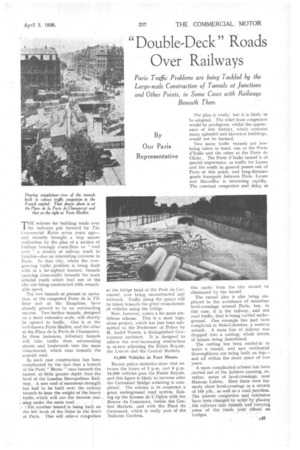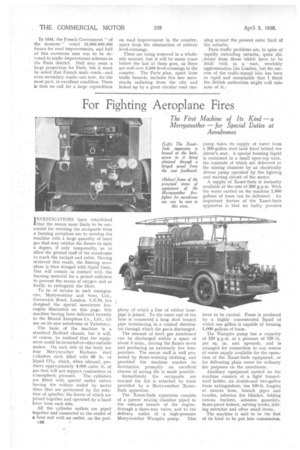"Double-Deck" Roads Over Railways
Page 69

Page 70

If you've noticed an error in this article please click here to report it so we can fix it.
THE scheme for building roads over the railways put forward by The Commercial Motor seven years ago— and recently brought a step nearer realization by the plan of a section of Fulham borough councillors to " roof over" a stretch of railway track in London—has an interesting converse in Paris. In that city, where the evergrowing traffic problem is being dealt with in a far-sighted manner, tunnels carrying cross-traffic beneath the main arterial roads which lead out of the city are being constructed with remarkable speed.
The two tunnels at present in operation, at the congested Porte de la Villette and at the Dauphine, have already proved to be an outstanding success. Two further tunnels, designed on a more extensive scale, will shortly be opened to traffic. One is at the well-known Porte Maillot, and the other at the Place de la Porte de Champerret. In these instances, tributary tunnels will take traffic from surrounding streets and boulevards into the main cross-tunnel, which runs beneath the arterial road.
In each case construction has been complicated by the fact that a branch of the Paris" Metro " runs beneath the tunnel, at little greater depth than the level of the London Metropolitan Railway. A new roof of enormous strength has had . to be built over the railway tunnels to bear the weight of the heavy , traffic„which will use the tunnels ,rim,sing under the main road..
f.Yet another tunnel .is, being built on the left bank of the Seine in the heart of Paris. This will relieve congestion at the bridge head of the Pont du Carroussel, now being reconstructed and widened. Traffic along the quays will be taken beneath the great cross-stream of vehicles using the bridge. .
Now, however, comes a far more ambitious scheme. This is a most ingenious project, which has just been submitted to the Prefecture of Police by M. Andre Ventre, a distinguished Government architect. It is designed to relieve the ever-increasing obstruction in streets adjoining the Palais Royale, the Louvre and the Central Markets.
14,000 Vehicles in Four I-Tours.
Recent police statistics show that between the hours of 2 p.m. and 6 p.m. 14,000 vehicles pass the Palais Royale, and this figure is likely to increase after the Carroussel Bridge widening is completed. The scheme is to construct a great underground. road ,system,
up the Avenue de VC:Opera with the Bourse du Commerce, beside .the 'Central Markets, and with the Place du Carroussel, which is really pad of the Tuileries Gardens. this outlet' from the city should be eliminated by the tunnel.
The tunnel idea is also being employed in the avoidance of suburban level-crossings around Paris, but, in this case, it is the railway, and not road traffic, that is being carried Underground. One example has just been completed at Bois-Colombes, a western suburb. A main line of railway was dropped into, a cutting, whole streets of houses being demolished.
The cutting has been roofed-in to make a tunnel, and new residential thoroughfares are being built on top— and all within the short space of two years.
A more complicated schemeshaS been carried out at the Acberes crossing, or, rather, series of level-crossings, near Maisons Lafitte_ Here there were formerly three level-crossings in a stretch of 109 yds., as well as a road junction. The intense congestion and confusion have been changed to 'order' by 'placing the railways' into tutitielS and 'carrying some of the 'toads OVer Othera on bridges . In 1934, the French Government "of the moment' voted 10,000,000,000 francs for road improvements, and half of this enormous sum was to be deVoted to traffic-improvement schemes in the Paris district. Half may seem a large proportion for Paris, but it must be noted that French main roads—and even secondary roads—are now, for the most part, in excellent condition. There is thus no call for a large expenditure on .road improvement in the country, apart from the elimination of railway level-crossings.
These are being removed in a wholesale manner, but it will be many years before the last of them goes, as there are well over 3,000 level-crossings in the country. The Paris plan, apart from traffic tunnels, includes five new autostrada radiating from the city and linked up by a great circular road run
ning around the present outer limit of the suburbs.
Paris traffic problems are, in spite of rapidly extending suburbs, quite different from those which have to be dealt with in a • vast, unwieldy agglomeration like London, but the success of the traffic-tunnel idea has been so rapid and remarkable that I think the British authorities might well take note of it./












































































































